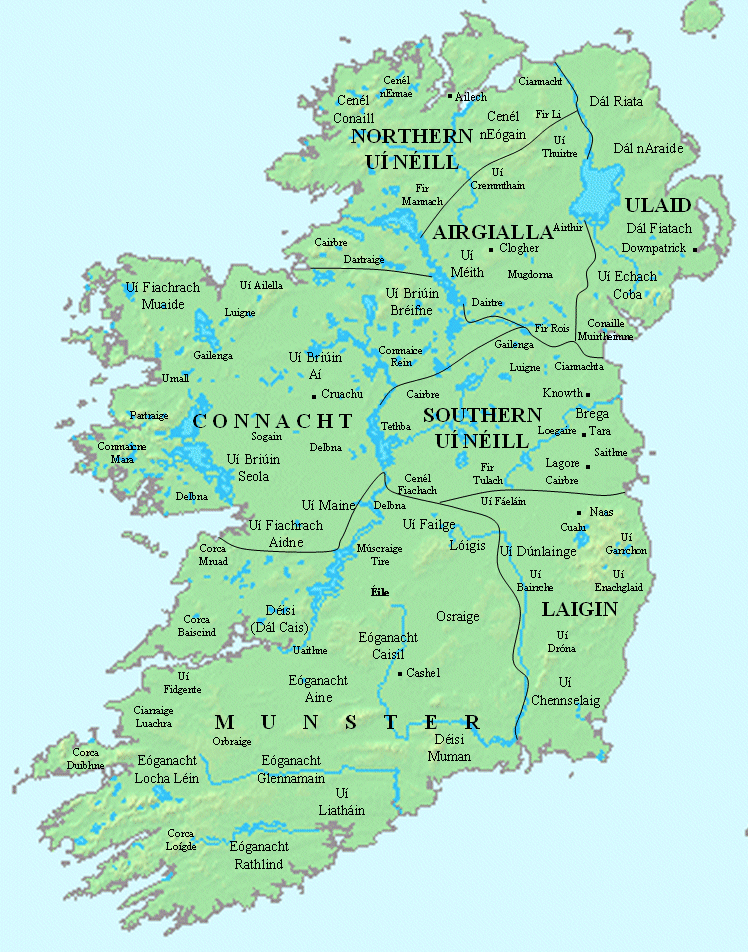
Congal Cennmagair
Encyclopedia

High King of Ireland
The High Kings of Ireland were sometimes historical and sometimes legendary figures who had, or who are claimed to have had, lordship over the whole of Ireland. Medieval and early modern Irish literature portrays an almost unbroken sequence of High Kings, ruling from Tara over a hierarchy of...
. He belonged to the northern Cenél Conaill
Cenél Conaill
The Cenél Conaill is the name of the "kindred" or descendants of Conall Gulban, son of Niall Noígiallach defined by oral and recorded history. They were also known in Scotland as the Kindred of Saint Columba....
branch of the Uí Néill
Uí Néill
The Uí Néill are Irish and Scottish dynasties who claim descent from Niall Noigiallach , an historical King of Tara who died about 405....
. His father, Fergus Fanát, was not a high king, although his grandfather, Domnall mac Áedo
Domnall mac Áedo
Domnall mac Áedo , also known as Domnall II, was a son of Áed mac Ainmuirech. Domnall was High King of Ireland from 628 until his death. He belonged to the Cenél Conaill kindred of the northern Uí Néill....
(died 642), was counted as a High King of Ireland.
Congal's predecessor was Loingsech mac Óengusso
Loingsech mac Óengusso
Loingsech mac Óengusso was an Irish king who was High King of Ireland. Loingsech was a member of the northern Cenél Conaill branch of the Uí Néill...
, his paternal first cousin, who died in battle in 703. Congal reigned as high king from 703 to 710.
Congal was a guarantor of Adomnán's "law of the innocents"—the Cáin Adomnáin
Cáin Adomnáin
The Cáin Adomnáin , also known as the Lex Innocentium was promulgated amongst a gathering of Irish, Dál Riatan and Pictish notables at the Synod of Birr in 697. It is named after its initiator Adomnán of Iona, ninth Abbot of Iona after St...
—agreed at the Synod of Birr
Synod of Birr
The Synod of Birr, held at Birr in modern County Offaly, Ireland in 697 was a meeting of churchmen and secular notables. Best remembered as the occasion on which the Cáin Adomnáin—the Law of Innocents—was guaranteed, the survival of a list of the guarantors of the law sheds some light...
in 697. He is the second lay guarantor listed after Loingsech and is called King of Tyrconell, though these titles may have been added later.
The reigns of Loingsech and Congal represented the peak of Cenél Conaill, thereafter eclipsed by the rival kinsmen the Cenél nEógain
Cenél nEógain
Cenél nEóġain is the name of the "kindred" or descendants of Eógan mac Néill , son of Niall Noígiallach who founded the kingdom of Tír Eoghain in the 5th century...
. Both appear to have attempted to expand into Connacht
Connacht
Connacht , formerly anglicised as Connaught, is one of the Provinces of Ireland situated in the west of Ireland. In Ancient Ireland, it was one of the fifths ruled by a "king of over-kings" . Following the Norman invasion of Ireland, the ancient kingdoms were shired into a number of counties for...
, with mixed results. Loingsech died in the pursuit of this goal, while in Congal's reign a notable victory was won against the men of Connacht in 707 and the Connacht king Indrechtach mac Dúnchado
Indrechtach mac Dúnchado
Indrechtach mac Dúnchado Muirisci was a King of Connacht from the Ui Fiachrach Muaidhe branch of the Connachta. He was the son of a previous king Dúnchad Muirisci mac Tipraite . He reigned from 705 to 707....
was slain. Congal himself did not participate in this battle but Loingsech's son Fergal did.
In the same year Congal himself campaigned in Leinster
Leinster
Leinster is one of the Provinces of Ireland situated in the east of Ireland. It comprises the ancient Kingdoms of Mide, Osraige and Leinster. Following the Norman invasion of Ireland, the historic fifths of Leinster and Mide gradually merged, mainly due to the impact of the Pale, which straddled...
. Geoffrey Keating
Geoffrey Keating
Seathrún Céitinn, known in English as Geoffrey Keating, was a 17th century Irish Roman Catholic priest, poet and historian. He was born in County Tipperary c. 1569, and died c. 1644...
's Foras Feasa ar Éirinn records that he burned the church of Kildare during this and implies his death was related to this.
Congal himself died suddenly in 710. A gloss to the Annals of Ulster
Annals of Ulster
The Annals of Ulster are annals of medieval Ireland. The entries span the years between AD 431 to AD 1540. The entries up to AD 1489 were compiled in the late 15th century by the scribe Ruaidhrí Ó Luinín, under his patron Cathal Óg Mac Maghnusa on the island of Belle Isle on Lough Erne in the...
adds that this was due to a fit. Congal left a number of sons, none of whom was especially prominent. These sons included Flann Gohan (died 732) and Conaing (died 733) who were slain in warfare between Cenél Conaill and Cenél nEógain and a son named Donngal (died 731). He was followed as High King by another northerner, Fergal mac Máele Dúin
Fergal mac Máele Dúin
Fergal mac Máele Dúin was High King of Ireland. Fergal belonged to the Cenél nEógain sept of the northern Uí Néill. He was the son of Máel Dúin mac Máele Fithrich , a King of Ailech, and great grandson of the high king Áed Uaridnach...
(died 722) of the Cenél nEógain.

